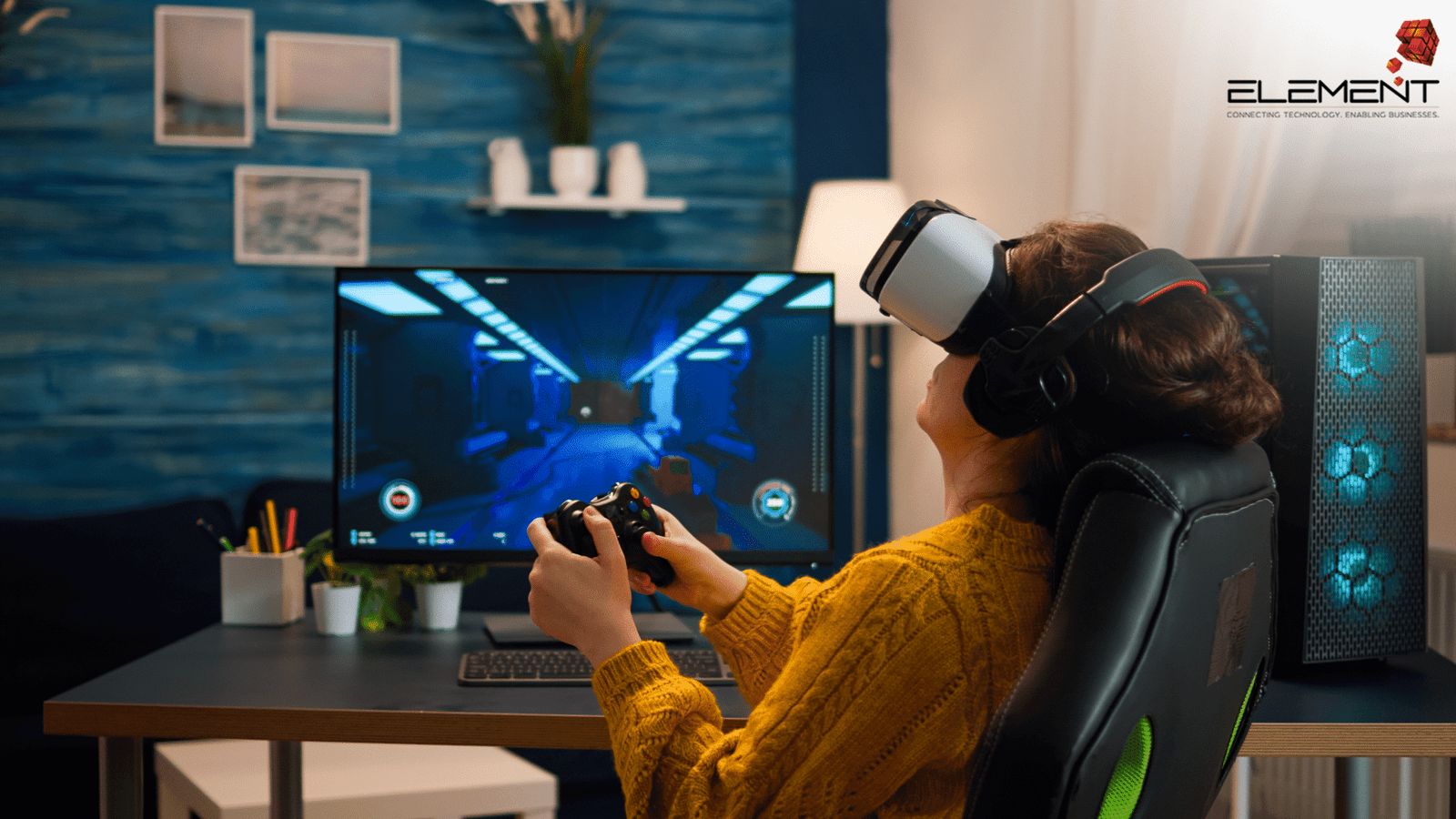Virtual Reality (VR) immerses players in fully digital realms, while Augmented Reality (AR) overlays gaming elements onto the real world. Both technologies are advancing rapidly—through devices like Apple’s Vision Pro, Meta’s Quest series, and AI-powered smart glasses—paving the way for a hybrid gaming future that blends realism, accessibility, and seamless digital-physical interaction.
1. The Current State of VR and AR in Mainstream Gaming
Over the past decade, Virtual Reality (VR) has evolved from a niche novelty into a serious contender in gaming. High-end devices like Sony’s PlayStation VR2 now offer OLED displays, ultra-high resolution visuals, eye tracking, and haptic controllers—delivering console-level immersion for players. Meanwhile, Meta’s Quest 3 and cost-friendly Quest 3S provide standalone VR experiences with pancake lenses, mixed reality features, and improved processing power, making VR more accessible to mainstream gamers.
Augmented Reality (AR), on the other hand, thrives on accessibility. With mobile-powered games like Pokémon Go, players can explore real-world locations while interacting with virtual elements layered on top of their surroundings. AR titles such as Minecraft Earth have demonstrated the potential for social engagement, creativity, and outdoor exploration—all without the need for bulky headsets.
Both VR and AR have distinct strengths: VR offers total immersion in fictional worlds, while AR enhances the real world with digital content, making them appealing to different player preferences.
2. The Market Growth Potential for VR and AR Gaming
The gaming industry’s investment in immersive tech is more than just hype—it’s backed by staggering growth projections:
- Global AR + VR gaming market: Expected to reach $52.7 billion by 2027.
- AR/VR combined market: Forecast to soar to $200.9 billion by 2030, and potentially $589 billion by 2034.
- XR (Extended Reality) revenue: Projected to grow from $21.4 billion in 2023 to $41.8 billion by 2028 at a CAGR of 14.4%.
- U.S. user base: Around 65.9 million VR users and 110.1 million AR users—indicating a massive adoption pipeline.
These numbers reveal not only current popularity but also enormous untapped potential—especially as hardware becomes more affordable and software ecosystems mature.
3. Real-World Innovations Shaping the Future
VR Hardware Breakthroughs
Meta’s prototype headsets, codenamed Tiramisu and Boba 3, are pushing VR limits with ultra-high fidelity visuals and dramatically expanded fields of view. While these require powerful computing hardware today, they point toward a future where VR headsets may feel lighter, sharper, and more responsive.
Smart Glasses & Lightweight Wearables
A shift is happening toward AI-powered smart glasses. Meta’s Ray-Ban Meta smart glasses have already outsold some of its VR products, suggesting consumers favor lightweight, socially acceptable wearables that can still deliver AR-like experiences.
Similarly, technology like Gaussian splatting is enabling photorealistic 3D environments that can be streamed or rendered efficiently, reducing the need for heavy rigs.
Platform Evolution
Apple’s visionOS 26 update for the Vision Pro introduces a dedicated gaming app, eye-based scrolling, and advanced AI tools—signaling Apple’s deeper commitment to immersive entertainment.
Infrastructure & Cloud Streaming
The arrival of 5G and cloud gaming platforms is making high-quality VR/AR experiences more accessible without expensive rigs. Gamers can stream immersive content with minimal latency, reducing the cost barrier.
4. VR vs AR – Will One Dominate or Will They Merge?
Industry trends suggest a convergent future where Extended Reality (XR) blends the best of VR and AR. Imagine seamlessly switching between full immersion in a fantasy world (VR) and having interactive holograms projected into your living room (AR)—all on the same device.
Major tech companies are already building hybrid-capable hardware, preparing for a world where “immersive gaming” isn’t limited to one reality type.
5. Pain Points and Practical Advice for Gamers
Pain Points
- Cost: High-end VR headsets and AR smart glasses can be expensive.
- Comfort: Bulky devices can cause fatigue during extended use.
- Content gaps: A shortage of “killer apps” that drive mass adoption.
- Platform fragmentation: Different ecosystems limit cross-play and app availability.
Practical Advice
- Start with accessible gear: Devices like Meta Quest 3/3S or PSVR2 (if you own a PS5) offer great entry points.
- Test AR on mobile: Games like Pokémon Go provide an easy way to experience AR without extra hardware.
- Track software updates: OS updates (like visionOS 26) can dramatically improve device capabilities.
- Watch the smart glasses market: Lightweight devices could soon deliver immersive gameplay without VR’s bulk.
- Consider cloud-based gaming: Avoid heavy investment by tapping into streaming services for immersive experiences.

6. Frequently Asked Questions (FAQs)
1. What’s the main difference between VR and AR in gaming?
VR immerses you fully in a virtual environment; AR overlays digital game elements onto the real world.
2. Are VR headsets affordable now?
Entry-level VR headsets like the Quest 3S (~$299) are more accessible, but high-end options remain pricey.
3. Can I play VR without a gaming PC?
Yes. Standalone headsets like the Meta Quest 3 work without a PC, and cloud streaming services are emerging.
4. Is AR only available on mobile devices?
No. AR is expanding to smart glasses such as Ray-Ban Meta and Xreal models.
5. Will VR headsets get lighter in the future?
Yes. Prototypes like Meta’s Tiramisu and Boba 3 promise improved comfort and visual clarity.
6. What software advancements are coming for immersive gaming?
Apple’s visionOS 26 will add new gaming features, improved eye tracking, and AI-powered enhancements.
7. Is there a “killer app” for VR or AR gaming?
Not yet, but hybrid games are emerging that blend AR and VR features.
8. How fast is the XR industry growing?
XR revenues are expected to nearly double between 2023 and 2028, driven by gaming innovations.
9. Will immersive tech replace traditional gaming?
It won’t replace it entirely, but it will reshape player expectations and experiences.
10. Should I wait for next-gen devices before buying?
If budget allows, current models are strong. But if you want the latest, upcoming smart glasses and lighter VR designs may be worth the wait.
7. Why This Analysis Is Trustworthy
This article draws from credible sources such as TechRadar, Tom’s Guide, The Verge, Wikipedia, and market research reports. It combines expertise (current tech trends), authoritativeness (industry data), and trustworthiness (balanced pros and cons) to provide a well-rounded perspective.
8. Key Takeaways
- VR offers unmatched immersion, ideal for exploring new worlds.
- AR fosters real-world engagement and social interaction.
- XR (blending AR + VR) is the most likely future direction.
- Hardware comfort, cost, and compelling games will decide adoption speed.
- Entry-level devices and mobile AR apps are great starting points.
- Keep an eye on cloud streaming, smart glasses, and OS updates for the next big leap.
Conclusion
The future of gaming doesn’t rest on VR or AR winning outright—it’s in their convergence into XR. Imagine gaming sessions where you can move from battling dragons in a fully virtual arena to teaming up with friends as holograms projected into your backyard—all with the same device.
With AI, cloud computing, and wearable innovations accelerating, immersive gaming is no longer a distant dream—it’s happening right now. The next few years will decide how deeply it integrates into mainstream play.
